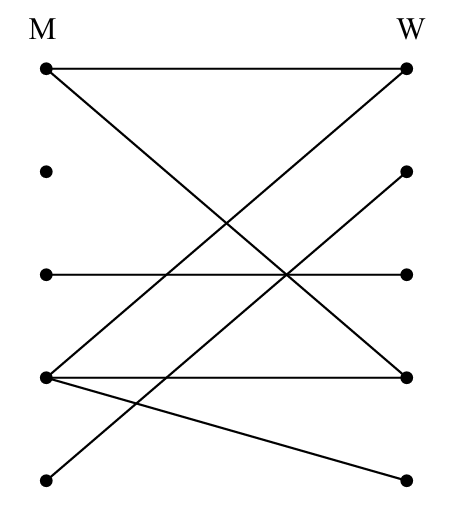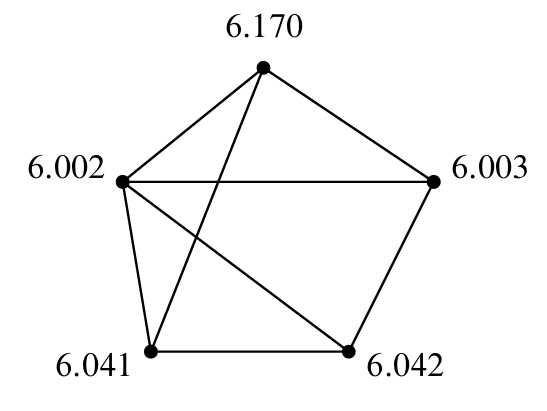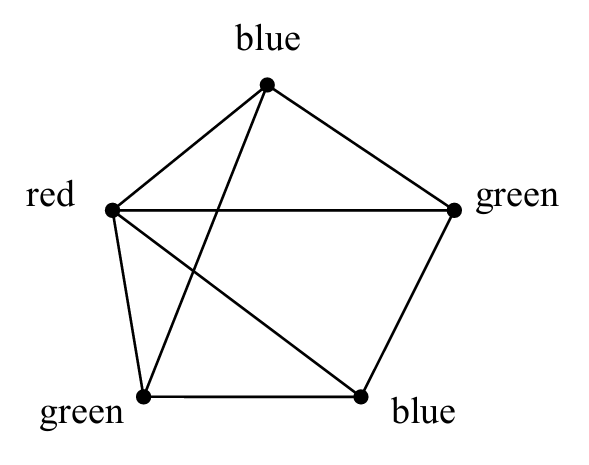- No self-loops or multiple edges (a.k.a multiedge).
- No directed edges.
Lecture 6: Graph Theory and Coloring
Definitions
Graphs
$ G = (V, E) $
- $ V $: non empty set of vertices (or nodes)
- $ E $: edges; set of two-element subsets of $ V $.
Adjacent
Two nodes $ x_i $ and $ x_j $ are adjacent if $ \{ x_i, x_j \} \in E $.
Incident
An edge $ e = \{ x_i, x_j \} $ is incident to $ x_i, x_j $.
Degree of a Node
The # of edges incident to a node.
Simple Graph

Matching Problems
Sex Example

- US population $ | V | $
- $ | M |, | F | $: male, female.
Let alone exactly which couples are adjacent, only need to figure out the relationship bw the average number of partners per male and per female.
Every edge is incident to exactly one M and one F $ \Rightarrow $ sum of the degrees of the M vertices = # of edges ($ | E | $) = sum of the degrees of the F vertices $$ \sum_{x \in M} \deg (x) = |E| = \sum_{y \in F} \deg (y) $$
- Avg # of opposite-gender partners for male $ A_m = \frac{\sum_{x \in M} \deg(x)}{|M|} = \frac{|E|}{|M|} $.
- Avg # of opposite-gender partners for female $ A_m = \frac{\sum_{y \in F} \deg(x)}{|F|} = \frac{|E|}{|F|} $.
The Handshaking Lemma
The sum of degrees of the vertices in a graph equals twice the number of edges.
Proof: Every edge contributes two to the sum of the degrees, one for each of its endpoints.
Coloring
Exam Scheduling Example

Assign time slot for final exam
- some students are taking several classes with finals
- a student can take only one test during a particular time slot
- adjacent vertices: some student is taking both courses
- 6.002 and 6.042 cannot have an exam at the same time since there’re student in both courses.

Slots
- blue: 6 - 8
- red: 9 - 11
- green: 13 - 15
Can’t do 2-coloring bc 6.002 - 6.170 - 6.041 forms a triangle and each one of these guys has to be different than the other two.
Chromatic number
$ \mathcal{X}(G) $: The minimum value of $ K $ for which $ G $ has a valid $ k $-coloring
Basic Algorithm (Greedy Color Algorithm)
Theorem 5.3.2
If every node in an $ n \text{-node } G $ has degree $ \leq d $
Then the Basic Algorithm uses at most $ d + 1 $ colors for $ G $.
- $ d $: biggest degree in the graph.
- $ n $: # of nodes.
Proof: By induction
Induction Hypothesis: $ P (n) = n$-node graph with maximum degree $ d $ is $ (d + 1) $-colorable
Base case: $ n = 1 \Rightarrow $ 0 edges, $ d $ = 0, 1 color = $ d $ + 1.
Inductive step: Assume $ P(n) $ is true for induction
Let
- $ G = (V, E) $ be any $ (n + 1) $-node graph
- $ d = $ max degree in $ G $.
Want to show: We can color it using $ d + 1 $ colors
Order the nodes $ V_1, V_2, \dots , V_n, V_{n + 1} $
Remove the $ V_{n + 1} $ from $ G $ to create $ G^{\prime} = (V^{\prime}, E^{\prime}) $
$ G^{\prime} $ has max degree $ \leq d $ and it has $ n $ nodes, so $ P(n) $
Says Basic Alg uses $ \leq d + 1 $ colors for $ V_1, V_2, \dots, V_n $